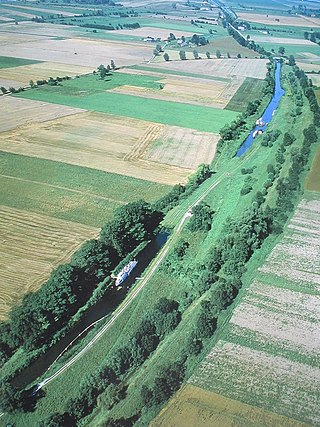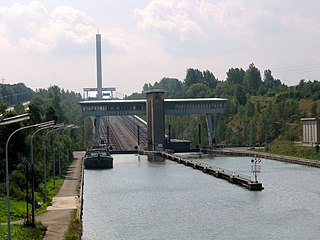
An inclined plane is a type of cable railway used on some canals for raising boats between different water levels. Boats may be conveyed afloat, in caissons, or may be carried in cradles or slings.

A boat lift, ship lift, or lift lock is a machine for transporting boats between water at two different elevations, and is an alternative to the canal lock.

The Bude Canal was a canal built to serve the hilly hinterland in the Cornwall and Devon border territory in the United Kingdom, chiefly to bring lime-bearing sand for agricultural fertiliser. The Bude Canal system was one of the most unusual in Britain.

The Hay Inclined Plane is a canal inclined plane in the Ironbridge Gorge in Shropshire, with a height of 207 feet (63 m). It was located at the end of the Shropshire Canal, part of a network of canals that linked the industrial region of east Shropshire with the River Severn. The inclined plane was in operation from 1793 to 1894. It can be visited as part of the Blists Hill Victorian Town and is also a waypoint on the South Telford Heritage Trail.

The Ketley Canal was a tub boat canal that ran for about 1.5 miles (2.4 km) from Oakengates to Ketley works in Shropshire, England. The canal was built about 1788 and featured the first inclined plane in Britain. The main cargo of the canal was coal and ironstone. The inclined ceased to be used in 1816, when Ketley Works was closed, but the upper canal was not finally abandoned until the 1880s. A few traces of the canal are still visible in the landscape.

Elbląg Canal is a canal in Poland, in Warmian-Masurian Voivodeship, 80.5 kilometres (50.0 mi) in length, which runs southward from Lake Drużno, to the river Drwęca and lake Jeziorak. It can accommodate small vessels up to 50 tonnes displacement. The difference in water levels approaches 100 metres (330 ft), and is overcome using locks and a system of inclined planes between lakes.

The caisson lock is a type of canal lock in which a narrowboat is floated into a sealed watertight box and raised or lowered between two different canal water levels. It was invented in the late 18th century as a solution to the problem posed by the excessive demand for water when conventional locks were used to raise and lower canal boats through large height differences. Such locks, each of which would only raise and lower boats through small height differences of a few feet, would not suffice when large height differences had to be tackled nor when water was in short supply. The caisson was thought to be one solution, although it transpired that the technology of the day was not capable of achieving this type of construction economically.
Dukart's Canal was built to provide transport for coal from the Drumglass Collieries to the Coalisland Canal in County Tyrone, Ulster, Ireland. It opened in 1777, and used three inclined planes, rather than locks, to cope with changes in level. There is little evidence that it was ever used, as the planes could not be made to work properly, and they were dismantled in 1787.

The Worsley Navigable Levels are an extensive series of coal mines in Worsley in the City of Salford in Greater Manchester, England. They were worked largely by the use of underground canals and boats called starvationers.

The Saint-Louis-Arzviller inclined plane is an inclined plane on the Marne-Rhine Canal that enables the canal to cross the Vosges Mountains. It is located in the commune of Saint-Louis, between the towns of Saint-Louis and Arzviller in the département of the Moselle.

The Ronquières Inclined Plane is a canal inclined plane on the Brussels-Charleroi Canal in the province of Hainaut in Wallonia, Belgium. It opened in April 1968 having taken six years to build. It is in the municipality of Braine-le-Comte and takes its name from the nearby village of Ronquières.

A water slope is a type of canal inclined plane built to carry boats from a canal or river at one elevation up or down to a canal or river at another elevation.

The Henrichenburg boat lift facilitates a change in elevation of the Dortmund-Ems-Kanal in Waltrop-Oberwiese. The boat lift is part of the Waltrop Lock Park (Schleusenpark), which includes the old Henrichenburg boat lift built in 1899, a disused shaft lock from 1912, the new boat lift built in 1962 and a modern ship lock from 1989.

The Niederfinow Boat Lift is the oldest working boat lift in Germany. It lies on the Oder-Havel Canal near Niederfinow in Brandenburg. The lift overcomes a difference in elevation of 36 metres.

The Montech water slope is a type of canal inclined plane built on the Canal de Garonne, in the commune of Montech, Tarn-et-Garonne, Southwest France. It is managed by the publicly owned Voies navigables de France and by-passes a series of five locks. The slope is used for larger vessels up to 40 metres in length, while smaller boats continue to use the locks.

A tub boat was a type of unpowered cargo boat used on a number of the early English and German canals.

The Wombridge Canal was a tub-boat canal in Shropshire, England, built to carry coal and iron ore from mines in the area to the furnaces where the iron was extracted. It opened in 1788, and parts of it were taken over by the Shrewsbury Canal Company in 1792, who built an inclined plane at Trench. It lowered tub boats 75 feet (23 m), and remained in operation until 1921, becoming the last operational canal inclined plane in the country. The canal had been little used since 1919, and closed with the closure of the plane.
James Green (1781–1849) was a civil engineer and canal engineer, who was particularly active in the South West of England, where he pioneered the building of tub boat canals, and inventive solutions for coping with hilly terrain, which included tub boat lifts and inclined planes. Although dismissed from two schemes within days of each other, as a result of construction problems, his contribution as a civil engineer was great.

The Fonseranes Water Slope is a disused inclined plane on the Canal du Midi parallel to the Fonseranes Lock. It has a rise of 13.6 m (45 ft) and a slope of 5°.



















